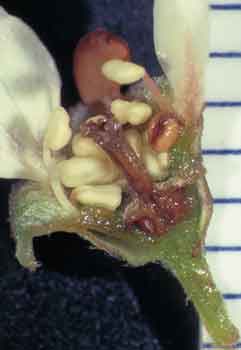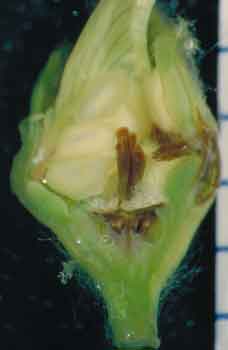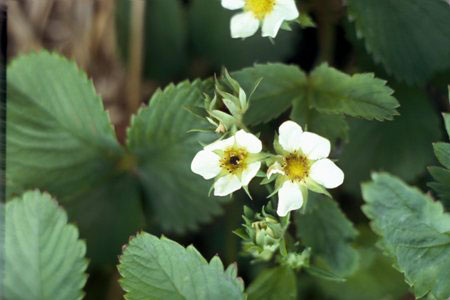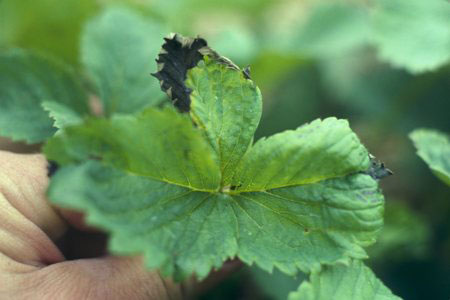Spring Frost Damage
Here are some details to help you assess your situation in the event a spring frost does occur.
Patience is the key as a proper assessment of frost damage cannot be made for several days until you can determine if new growth is occurring from damaged plants.
The Basics Of What Causes Frost Damage
In plants, frost damage occurs when the water contained inside the plant (inside the individual plant cells) freezes. As the water freezes, it forms ice crystals within the plant that actually puncture plant cell walls.
When the air temperature warms up, the ice crystals melt and the cell contents leak out causing the frozen plant leaves to appear limp and take on a dark, watery complexion.
Environmental Factors Which Influence The Degree Of Frost Damage
If recent cool and cloudy weather conditions prevailed prior to the frost event, these conditions may have slowed plant growth but has allowed plants to harden off which allows plants to be more tolerant to slight frost conditions.
The hardening off process either allows plants to become "accustomed" to lower temperatures or individual plant cells accumulate more solutes that can lower their freezing point, much like antifreeze in your trucks radiator. However, even with hardening, frost damage can still occur in localized areas.
If soil conditions are moist, this may be a factor in reducing the impact of a slight frost since temperatures change more slowly in wetter soils than in dryer soils. The free water outside of plants in the form of wet soils reduces freeze injury because free water will freeze before the water inside plant cells freeze.
Slow warming following sub-zero conditions minimizes the effects of frost. Rapid warming, dry conditions, wind and high evaporation aggravate frost injury and the chance of plant recovery is reduced.
Although not considered an environmental factor, high crop residues may increase frost injury. Residues will act as a barrier for heat transfer from the soil to the plant, increasing the potential for frost injury.
The colder the air temperature and the longer it lasts will affect the amount and degree of plant injury and is outlined for specific crops in more detail below. In general, frost damage to plants can vary from complete death to the best case scenario of where injury is evident but seedlings remain vigorous and complete recovery can be expected.
Spring Cereals | Winter Wheat | Corn | Canola | Sunflowers | Flax | Potatoes | Peas | Soybeans | Edible Beans | Fruit Crops |
Cereal Crops
Spring Cereals
Spring cereals such as wheat, barley and oats are very tolerant to temperatures as low as -6°C since the growing point is below the soil surface until the 5 leaf stage to jointing. Frost damaged spring cereals will have wilted, dark green and discolored leaves and will become necrotic at the leaf tips within 1 or 2 days after freezing. However, new leaf growth (normal green color) from the growing point should follow within 2-3 days.
Winter Wheat
Winter wheat can be impacted by frost damage depending on how low the temperature goes and the growth stage (see Table 1). Winter wheat at the tiller stage can withstand very low temperatures for a period of time (-11°C for less than 2 hours). Frost damaged winter wheat at this stage will have leaf chlorosis and necrotic leaf tips. However, the effect on yield will be slight.
Table 1
Growth Stage |
Approximate Injurious Temperature (two hours) |
Primary Symptoms |
Yield Effect |
Tillering |
-11°C |
Leaf chlorosis; burning of leaf tips; may reduce tiller number |
Slight to moderate |
Jointing
|
-4°C |
Death of growing point; leaf yellowing or burning; lesions, splitting or bending of lower stem |
Moderate to severe |
Boot |
-2°C |
Floret sterility; spike trapped in boot; damage to lower stem; leaf discoloration |
Moderate to severe |
Heading |
-1°C |
Floret sterility; white awns or white heads; damage to lower stem; leaf discoloration |
Severe |
Flowering |
0°C |
Floret sterility; white awns or white heads, damage to lower steam; leaf discoloration |
Severe |
Source: Freeze Injury on Wheat by Dr. B.E. Warrick & Dr. T.D. Miller. Texas Agricultural Extension Service, Texas A&M University, 1999.
Winter wheat entering the jointing stage is very sensitive to frost damage. Even if there is not extensive leaf damage, check the health of the growing point because the growing point is more susceptible to damage than leaf tissue. A healthy growing point should be bright white to yellow-green in color and turgid. However, a damaged growing point will appear brownish or water soaked. Other symptoms may include a dead leaf appearing in the whorl if the growing point was damaged, leaf yellowing or burning, and lesions, splitting or bending of the lower stem. Frost at jointing will have a moderate to severe effect on yield potential.
Winter wheat entering the boot stage of development is also very sensitive to frost damage. Freezing when the heads are enclosed in the sheath or the flag leaves may trap the head inside the boots so they cannot emerge normally. If this happens, the heads will remain in the boots, split out the sides of the boots, or emerge base-first from the boots. Sometimes the spikes do emerge normally but remain yellow or even white instead of their usual green color. If this is evident, the heads have been killed.
Frost damage at this stage may also cause sterility as the only the anthers of the flowers of the head are killed. Sterility caused by freeze injury results in poor kernel set. This type of injury can be determined soon after freezing by examining anthers inside each floret with a hand lens. Within 48 hours of the freeze event, the anthers will still be green but will be twisted and shrivelled. They will then turn white to whitish-brown and may not emerge from the florets.
Much of the above information was taken from Wheat Freeze Injury in Texas. This document includes information on other growth stages along with excellent photos illustrating the possible symptoms of freeze injury.
Corn
Corn in the V5 stage (5 leaves with collars showing) or less will recover from light frosts because the growing point is still below the soil surface. Frost will often kill young corn leaves but plants, even with extensive leaf damage, will likely recover if the growing point was not injured. The death of leaf tissue above the growing point has only a small effect on corn growth and yield at early stages of development. While extremely rare, if air temperatures drop to temperatures of -2°C or less for more than a few hours, the growing point region of a young corn plant can be injured or killed even if it is still below the soil surface.
The best way to assess the impact of frost damage to young corn is to leave the field alone for three to five days, then evaluate the degree of plant recovery. Be aware however that cool days following a frost event may slow the plant's recovery and delay the ability to assess their health.
To assess corn plants, look at the growing point approximately 3 to 5 days after the frost occurred. The growing point can be found by pulling up the entire corn plant, including roots, and splitting the entire plant lengthwise. If the growing point is white or creamy in appearance, injury did not occur. By this time, surviving corn plants should be showing new leaf tissue expanding from the whorls. Damaged tissue in the growing point region will be discolored and soft or "water-soaked". There will also be a lack of new regrowth from the whorl.
To assess damage in corn that has not emerged, dig up a few seeds to check for germination and to see if the seedling is viable. Seeds that have not germinated will not be adversely affected but non-emerging seedlings could be affected if soil temperatures were very cold. Non-lethal injury by cold temperatures may cause deformed elongation of the mesocotyl. There is also possible physical damage to the coleoptile in non-emerged seedlings resulting in "cork-screw" symptoms and subsequent leafing out underground.
Oilseed Crops
Canola
Canola seedlings will usually recover from a light frost that can wilt leaves, but does not damage the growing point. The actual temperature where frost injury occurs varies with the plant's growth stage, moisture content and the duration that temperatures are below freezing. For example, canola at the cotyledon stage is more susceptible to frost damage than plants at the three to four-leaf stage.
The extent of injury needs to be assessed 3 to 5 days after the frost, as time is required to determine the amount of damage and status of the growing point. If the growing point is green, firm and does not appeared pinched off, the plant will recover. If cotyledons and/or leaves are blackened, wait for 3 or 4 days to see if they will recover. Under good growing conditions, green re-growth from the growing point should occur in 4 to 5 days. Under poor growing conditions; cold and/or dry, this can take up to 10 days.
In 2009, an early June frost affected canola fields in Manitoba. Fields showing the greatest frost damage also had higher trash cover, flea beetle feeding, seedlings sitting in too dry soil or emerging from deeper soil depths that left the canola more vulnerable.
When evaluating fields, walk in a diagonal path across the field stopping every 20 paces and evaluating a foot square section (make an 'L' with you feet and count plants within the 'square'). Consider the percentage of plants killed, recovered, and the weed population. A minimal plant stand of 4 plants/ft2 throughout the majority of the field is sustainable for a crop, as long as weeds are controlled. Weed control in any field with lower plant stands is crucial to maintaining yields. Canola can compensate for lower plant stands as surviving plants will take advantage of reduced competition for light, moisture and nutrients. Plants will grow larger, produce more branches, pods and seeds per pod, but will require longer to mature. However, they will still be earlier maturing than if the entire field is re-seeded.
Sunflowers
Sunflowers are fairly frost tolerant up to the V4 or 4 leaf stage. The cotyledons just emerging are most frost tolerant, with risk of injury increasing as the plant adds leaves. If sunflowers become brown or black and the terminal bud is severely damaged, plants will not recover. Less severe frost damage may result in loss of apical dominance and plants will exhibit branching from axillary buds, resulting in multiple heads later in the season.
Tolerance to frost in sunflowers can be influenced by the hardening off process. If it is cool or cold for several days previous to the frost, seedlings may have better tolerance to lower temperatures.
Flax
Like other oilseed crops, the staging of the flax plant will determine susceptibility to frost damage. When flax is first emerging, it is the most susceptible to spring frost, but can still tolerate a light frost for a few hours. After the 2 whorl stage, when the plant has hardened off, it can withstand temperatures below freezing. Depending on environmental conditions the days prior to and afterwards, a -8°C can be survived. One thing to look for with flax is 'frost canker', where plants are girdled at or near the soil surface, causing the plant to fall over.
Potatoes
Early planted potatoes that have emerged could potentially be affected by frost. If the emerged shoots are damaged by frost, the plant will produce new shoots from the surviving unfrozen portions of the sprout still below the soil surface. This leads to an increased number of stems per plant as well as a delay in emergence which can increase the risk of seed piece decay. The increased number of stems can usually be correlated with an increased number of tubers and lower average tuber size at harvest. Frost injury to the plants will add to the length of time the plant requires to mature properly. Therefore the chemical maturity of the daughter potatoes at harvest will potentially be delayed as the plants had fewer days to adequately mature.
Pulse Crops
Peas
Peas are more tolerant of frost than either edible beans or soybeans. Pea crops are rarely lost from early spring frosts because they can have 2 nodes (growing points) on the plant stem between the seed and soil surface. If the growing point is killed, these nodes become active and each node will send a shoot to the soil surface. The pea plant would mature later than other pea plants that did not have their main shoot killed. Yield potential of the frosted pea plants would be determined by environmental conditions during flowering.
Soybeans
Due to the variability of the frost, the level of soybean injury has to be evaluated on a field by field basis. Generally frost injury is more severe on fields with heavy residue from previous crops.
When it comes to emerged soybean seedlings and freezing, size really does matter. While soybeans are sensitive to frost, the smaller the soybean plant the more tolerant they are to frost. Soybean plants that are just cracking through the soil (VE) and up to the cotyledon stage (VC) can tolerate -2.8°C for a few hours.
The most advanced soybean fields are between the cotyledon and unifoliate growth stage. Soybeans exposed to frost at the cotyledon stage may leaf out again, however, you will have to wait 3 to 5 days before going out to look for signs of new growth. At the cotyledon stage soybeans have three potential growing points: the main shoot and two axillary buds that are located at the base of the cotyledons. Under normal conditions the axillary buds never grow, but if the main growing point is killed by frost, the two axillary buds will start to grow within a week of the frost event. Under the current cool, cloudy conditions you may have to wait up to a week before you see any sign of recovery. During the summer, one of the axillary branches will become dominant and be the main stem of the soybean plant.
Soybean plants that were still below the soil surface were not affected by the frost and will emerge normally.
Even soybean fields that suffered a lot of frozen plants do not automatically have to be reseeded. Soybeans have a tremendous ability to compensate for reduced stand when scattered plants are removed, especially on fields seeded for a final plant population of 200,000 plants per acre or more. Soybeans cannot compensate for large areas of stand loss.
Edible Beans
Edible beans that have not emerged would not have been injured by the frost.
Edible beans are more sensitive to frost than soybeans. This could be the reason why we do not see a lot of regrowth from axillary buds like we do with soybeans. Growers will have to wait 4 to 6 days to look for signs of growth from the main growing point and make a decision at that point. The level of edible bean injury has to be evaluated on a field by field basis.
Fruit Crops
Strawberry, Saskatoon And Other Tree Fruit Orchards
With the return of cooler weather, many of the tree fruits (saskatoons, chokecherry, etc.) have advanced to the flowering or pre-bloom phase with the extremely warm temperature in April. The possibility of frost in some areas of the province may put saskatoons, other tree fruit and early season strawberry (e.g. cultivars Annapolis, Sable) flowers at risk of damage. Some saskatoon orchards are at balloon or full flower phase so they may be at the greatest risk of frost damage, while for early season strawberry flowers are just starting (5% flowering or less).
The amount of damage to the flower tissue depends on many factors such as length of frost event, lowest temperature achieved, soil temperature/moisture levels (heat release from the soil by conductivity) and precipitation (snow/rain) occurring during frost event (may help protect plant similar to irrigation method).
Keep in mind that temperatures can be 2 to 3 degrees cooler than temperatures reported by weather stations, which are taken at shoulder level. Therefore, thermometers or electronic temperature alarms should be located in low spots where frost would usually occur first.
Saskatoons Frost Tolerance And Injury Symptoms
Saskatoon flowers and newly-set fruit are susceptible to damage with frosts at -2.2ºC or lower. Below this temperature actively growing plant tissues (e.g. flower buds) are killed or damaged. This damage may be visible within one hour to a couple of days after the frost. Symptoms of frost damage are not always visible, but look for slight browning of internal flower tissue and slight browning of flower petals.
Saskatoon flower buds can tolerate lower frost temperatures depending on its stage of development. Detailed frost tolerance research on apples, which is in the same family, indicate the following: tight bud flower stage can tolerate -8ºC, first pink -6ºC, full pink -4.6ºC, first bloom -4ºC, full bloom -4.7ºC and post bloom -3ºC. Note: These temperatures would have to be present for 30 minutes with an expected kill rate of 90%.
See photos of frost damaged saskatoon flowers (PDF 144KB):
 |
 |
Photo credit: Richard St.Pierre
Strawberries Frost Tolerance And Injury Symptoms
Strawberry flower buds and fruit are susceptible to frost injury any time after bud break (-1ºC or lower). Frost damages the center of the flower with the center turning black while the petals and leaves appear uninjured. The blackening occurs within a few hours to one day after the frost. Frost can also damage the developing fruit, deforming the berries.
Frost injury rarely causes complete crop loss because the strawberry plant produces flowers over a two to three week period. The first flowers to open are the largest and face the greatest risk of frost injury. Closed buds are also sensitive to frost damage. Frost losses can range from 20 to 80% depending on the temperature and the duration of the frost, the cultivar, vigor, stage of development and the weather preceding the frost.
Strawberry flower buds can tolerate lower frost temperatures depending on its stage of development. For example tight bud flower stage can tolerate -5ºC, tight with white petals -2.2ºC, full bloom -1ºC, past full bloom and immature fruit can tolerate -2.2ºC. Note: These temperatures would have to be present for 30 minutes with an expected kill rate of 90%.
Frost Protection Measures
Most strawberry fields in the past have been irrigated by solid set irrigation which allows for quick conversion to a frost protection system. However with the increased use of drip tape in strawberry fields and all saskatoon orchards this method is not available. Mild frost damage can be controlled by management practices other than solid set irrigation. These include not tilling the soil during the frost risk period in early spring. Untilled soil acts as a heat sink during the day and this heat is released during the night to protect the plants. Irrigation prior to a frost will provide an increased heat release from the soil by conductivity. The use of polyethylene covers will reduce damage to flowers caused by light frosts and cold winds. Long term measures include thinning out shelterbelts surrounding the orchard to allow for more air flow and reduce the problem of frost pockets on the site.
Saskatoon orchards may have to consider using frost control measures practiced by other tree fruit orchards in Canada in order to protect their yield and investment. Such measures include use of wind machines, outdoor heaters/fires and artificial fogs. These measures more effective with radiation frost than advection frosts (see frost type definitions below). However the cost of setting up such systems must be balanced with value of the crop. In vineyards where crops are very valuable, costly measures to protect a crop can be justified.
The Frost Control Principle And Frost Injury Levels
As water freezes, heat is released, keeping the plant parts above the freezing point. This frost control method is effective down to about -6.6°C. The key to utilizing this principle successfully is to leave the irrigation system operating until after sunrise to ensure that the ice will melt.
A temperature of -1°C at the plant level may cause slight injury to open flowers. A medium injury to open flowers can be expected at -2°C. Temperatures below -3°C at the plant level will cause severe injury to buds and developing berries.
Key tools for frost control include an automatic thermal alarm, several probe sensors or thermistors and several accurate thermometers. The thermistors are placed in the flower buds of two random plants, preferably with one plant located in a low area of the field and the other beyond the frost protection system. The thermometers should be placed at the thermistor locations as a double check. A comparison of the readings at the two sites will help determine when to stop the irrigation system. These are the key steps for frost control:
- Start the sprinklers just before the air temperature at ground level reaches 0°C, use nozzles designed for frost protection (low output rate, metal).
- Apply 2.5 to 3 mm/h. (1/10 to 1/8 in./h.). At this rate 655 to 822 L/ha (60 to 75 gal./acre) of water is applied.
Do not stop when ice begins to form on the plants. - Operating time needed to control frost varies from 3 to 15 hours, but usually takes 8 to 10 hours. A slight breeze or cloud cover during the night may temporarily raise the temperature about the freezing point, but the temperature can drop below freezing just as quickly if conditions change.
- Ice may form anywhere from 1.6 to 12 mm thick (1/16 to ½ in.) depending on the intensity and duration of the frost. This does not seem to injure low growing strawberry plants.
- Leave sprinklers on until the temperature increases enough to start melting the ice that has formed.

Photo 1: The strawberry blossom on the left is frost injured. The pistils (female flower parts) are darkened and killed, while the stamens (male parts) and the rest of the flower show no injury. The strawberry blossom on the right has not been frost injured.

Photo 2: Strawberry leaf frost damaged, with black curled leaf edges.
Definitions:
Radiation Frost - Clear; calm; inversion; temperature greater than 0°C during day
Advection Frost- Windy; no inversion; temperature can be less than 0°C during day
References:
St. Pierre, R. Growing Saskatoons: A Manual for Orchardists. 1997, University of Saskatchewan.
Snyder, R. and Paulo de Melo-Abreu, J. Frost Protection: fundamentals, practice, and economics. Vol. 1. 2005, Food and Agriculture Organization of the United Nations.
Commercial Strawberry Production on the Prairies. AAFRD, SAFRR and MAFRI. 2005.

